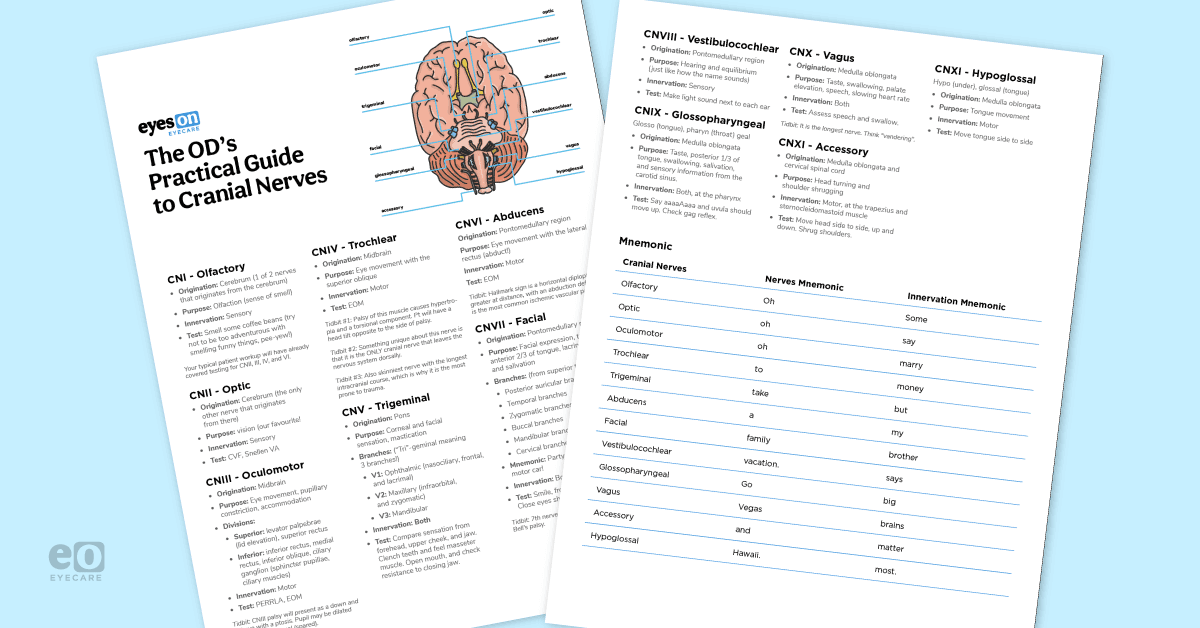A neurological exam is an important tool in a patient assessment and having a firm handle on neurological concepts and terminology is key. Optometrists should evaluate cranial nerves if they suspect underlying etiologies like stroke, lesions, demyelinating disease, head trauma, or Bell’s palsy. Ocular findings such as double vision, ptosis, pupil abnormalities, and vision loss may also come up as red flags.
Download the OD's Practical Guide to Cranial Nerves cheat sheet for a handy table + mnemonics!

Get the cranial nerves cheat sheet!
Download the cheat sheet for easy reference to cranial nerves I - XI, plus handy mnemonics!

Remember: cranial nerves can be afferent, efferent, or both
Let’s start off with a simple anatomy of the brain to help guide us in learning the positions of these nerves. Cranial nerves originate from the brain or brainstem. They are numbered from where they emerge: front to back. They can be either afferent (sensory), efferent (motor), or sometimes both! Let’s get started . . .
CNI - Olfactory
- Origination: Cerebrum (1 of 2 nerves that originates from the cerebrum)
- Purpose: Olfaction (sense of smell)
- Innervation: Sensory
- Test: Smell some coffee beans (try not to be too adventurous with smelling funny things, pee-yew!)
Your typical patient workup will have already covered testing for CNII, III, IV, and VI.
CNII - Optic
- Origination: Cerebrum (the only other nerve that originates from there)
- Purpose: vision (our favorite!)
- Innervation: Sensory
- Test: CVF, Snellen VA
CNIII - Oculomotor
- Origination: Midbrain
- Purpose: Eye movement, pupillary constriction, accommodation
- Divisions:
- Superior: levator palpebrae (lid elevation), superior rectus
- Inferior: inferior rectus, medial rectus, inferior oblique, ciliary ganglion (sphincter pupillae, ciliary muscles)
- Innervation: Motor
- Test: PERRLA, EOM
Tidbit: CNIII palsy will present as a down and out eye with a ptosis. Pupil may be dilated (involved), or normal (spared).
CNIV - Trochlear
- Origination: Midbrain
- Purpose: Eye movement with the superior oblique
- Innervation: Motor
- Test: EOM
Tidbit #1: Palsy of this muscle causes hypertropia and a torsional component. Pt will have a head tilt opposite to the side of palsy.
Tidbit #2: Something unique about this nerve is that it is the ONLY cranial nerve that leaves the nervous system dorsally.
Tidbit #3: Also skinniest nerve with the longest intracranial course, which is why it is the most prone to trauma.
CNV - Trigeminal
- Origination: Pons
- Purpose: Corneal and facial sensation, mastication
- Branches: (“Tri”-geminal meaning 3 branches!)
- V1: Ophthalmic (nasociliary, frontal, and lacrimal)
- V2: Maxillary (infraorbital, and zygomatic)
- V3: Mandibular
- Innervation: Both
- Test: Compare sensation from forehead, upper cheek, and jaw. Clench teeth and feel masseter muscle. Open mouth, and check resistance to closing jaw.
CNVI - Abducens
- Origination: Pontomedullary region
- Purpose: Eye movement with the lateral rectus (abduct!)
- Innervation: Motor
- Test: EOM
Tidbit: Hallmark sign is a horizontal diplopia, greater at distance, with an abduction deficit. It is the most common ischemic vascular palsy.
CNVII - Facial
- Origination: Pontomedullary region
- Purpose: Facial expression, taste, anterior ⅔ of tongue, lacrimation, and salivation
- Branches: (from superior to inferior)
- Posterior auricular branch
- Temporal branches
- Zygomatic branches
- Buccal branches
- Mandibular branches
- Cervical branches
- Mnemonic: Party to Zanzibar by motor car! Try using your hand to imagine the distribution.
- Innervation: Both
- Test: Smile, frown, puff out cheeks. Close eyes shut.
Tidbit: 7th nerve palsy is also known as Bell’s palsy.
CNVIII - Vestibulocochlear
- Origination: Pontomedullary region
- Purpose: Hearing and equilibrium (just like how the name sounds)
- Innervation: Sensory
- Test: Make light sound next to each ear
CNIX - Glossopharyngeal
Glosso (tongue), pharyn (throat) geal
- Origination: Medulla oblongata
- Purpose: Taste, posterior ⅓ of tongue, swallowing, salivation, and sensory information from the carotid sinus.
- Innervation: Both, at the pharynx
- Test: Say aaaaAaaa and uvula should move up. Check gag reflex.
CNX - Vagus
- Origination: Medulla oblongata
- Purpose: Taste, swallowing, palate elevation, speech, slowing heart rate
- Innervation: Both
- Test: Assess speech and swallow.
Tidbit: It is the longest nerve. Think “vandering”.
CNXI - Accessory
- Origination: Medulla oblongata and cervical spinal cord
- Purpose: Head turning and shoulder shrugging
- Innervation: Motor, at the trapezius and sternocleidomastoid muscle
- Test: Move head side to side, up and down. Shrug shoulders.
CNXII - Hypoglossal
Hypo (under), glossal (tongue)
- Origination: Medulla oblongata
- Purpose: Tongue movement
- Innervation: Motor
Test: Move tongue side to side
